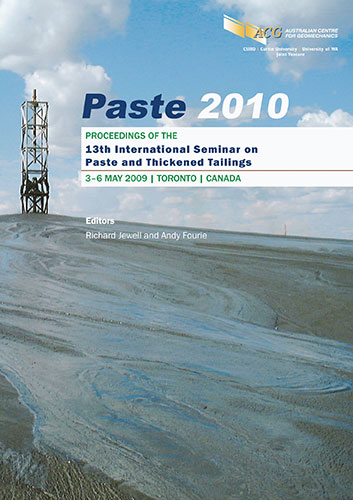Polymer modified paste fill for isolation of waste disposal sites

|
Authors: Fall, M; Celestin, JC; Han, FS |
DOI https://doi.org/10.36487/ACG_rep/1063_5_Fall
Cite As:
Fall, M, Celestin, JC & Han, FS 2010, 'Polymer modified paste fill for isolation of waste disposal sites', in R Jewell & AB Fourie (eds), Paste 2010: Proceedings of the Thirteenth International Seminar on Paste and Thickened Tailings, Australian Centre for Geomechanics, Perth, pp. 51-60, https://doi.org/10.36487/ACG_rep/1063_5_Fall
Abstract:
Engineering of waste containment facilities such as solid and hazardous waste landfills and mine waste repositories usually requires the construction of a barrier (liner, cover). The liners are usually needed to minimise the downward flux of contaminants, while the covers generally limit the accessibility of fluid (e.g. rain water) to the waste. The barrier will drastically reduce the potential impact of the waste disposal on the environment (e.g. groundwater, surface water, and ecosystem). In this paper, the results of research on potential use of polymer modified paste fill (PMP) as barrier material for waste containment facilities are presented and discussed. The saturated hydraulic conductivity of PMP mixes with different SAP (super absorbent polymer) contents were investigated at various compaction degrees. Furthermore, the relative cost and the resistance of the PMP materials to environmental stresses (freeze-thaw and wet-drying cycles) were evaluated. Valuable and encouraging results were obtained. The results have shown that possibilities of using PMP as barrier materials appeared very promising owing their good hydraulic performance, relative good resistance to environmental stresses and the reduced cost from the low admixture amount necessary to further improve this performance. The cost of a conventional barrier material made using bentonite (12%) and sand is higher than any of the studied amounts of SAP required to be mixed in the paste fill to achieve the recommended low conductivity. The benefit realised could be estimated to 98, 96 and 90% when using PMP material containing 0.10, 0.20 and 0.5% of SAP polymer.
References:
ARK (2003) The ARK Enterprises, Inc. PO box 725, Peculiar, Missouri 6407., viewed January 2010,
Benson, C.H. and Othman, M.A. (1993) Hydraulic conductivity of compacted clay frozen and thawed in-situ, Journal of
Geotechnical Engineering, ASCE, Vol. 119(2), pp. 276–294.
Daniels, J.L., Inyang H. and Iskandar, I.K. (2003) Durability of Boston blue clay in waste containment applications,
Journal of Materials in Civil Engineering, Vol. 15(2), pp. 144–152.
Eigenbrod, K.D. (2003) Self-healing in fractured fine grained soils. Canadian Geotechnical Journal, Vol. 40(2),
pp. 435–449.
Fall, M., Adrien, D., Célestin, J.C., Pokharel, M. and Touré, M. (2009) Saturated hydraulic conductivity of cemented
paste backfill, Journal Minerals Engineering, Vol. 18, pp. 1307–1017.
Fall, M., Célestin, J.C. and Han, F.S. (2009b) Suitability of benonite-paste tailings as engineering barrier material for
mine waste containment facilities, Journal Minerals Engineering, Vol. 22, pp. 840–848.
Fall, M. and Merkel, B. (eds) (2001) Kontamination aus der Nutzung von Ressourcen – Probleme und Lösungen, In
Proceedings First conference of Geo-Environment of the Graduatenkolleg (272), Geowissenschaftliche und
Geotechnische Umweltforschung – TU Freiberg – Germany, Wissen. Mitt. Institut für Geologie.; Heft 18.
20 Beiträge, 200 p.
Kashir, M. and Yanful, E.K. (2001) Hydraulic conductivity of bentonite permeated with acid mine drainage, Canadian
Geotechnical Journal, Vol. 38(5), pp. 1034–1048.
Qiu, Y.J. and Sego, D.C. (2001) Laboratory properties of mine tailings, Canadian Geotechnical Journal, Vol. 38 (1),
pp. 183–190.
Wong, L.C. and Haug, M.D. (1991) Cyclical closed-system freeze-thaw permeability testing of soil liner and cover
materials, Canadian Geotechnical Journal, Vol. 28, pp. 784–793.
© Copyright 2025, Australian Centre for Geomechanics (ACG), The University of Western Australia. All rights reserved.
View copyright/legal information
Please direct any queries or error reports to repository-acg@uwa.edu.au
View copyright/legal information
Please direct any queries or error reports to repository-acg@uwa.edu.au